Suillus Adans.
A number of species are known in Europe. Fruitbody boletoid without or with partial veil, and then leaving a ring on the stipe. Cap in most species more or less viscid. Stipe solid.
Suillus variegatus (Sw. : Fr.) Kuntze
Description
Cap up to 10 cm, at first hemispherical then expanding to convex, yellowish ochraceous, ochraceous or yellowish brown, usually dry, velvety or finely scaly. Stipe, cylindrical or slightly swollen at the base, more or less concolorous with the cap. Flesh yellowish in the cap and with pronounced dirty orange tint in the stipe, blueing in the cap, mostly above the tubes. Tubes dirty yellowish then mustard coloured. Pores small, rounded, mustard coloured. Smell not distinctive. Taste acid. Spores 8–11 × 3–4 μm.
Habitat. Coniferous forests, but also in artificial plantations, mycorrhizal with pines (Pinus).
Distribution. Widespread throughout Europe.
Similarity. The only European Suillus with blueing flesh if one does not count the alien Suillus lakei, which grows under Douglas’ fir (Pseudotsuga) and has partial veil which leaves distinct ring on the stipe after disruption. Confusion is probably possible with Suillus plorans which has usually darker cap, dotted stem, unchanging flesh and grows under five-needled pines only.
Photographs
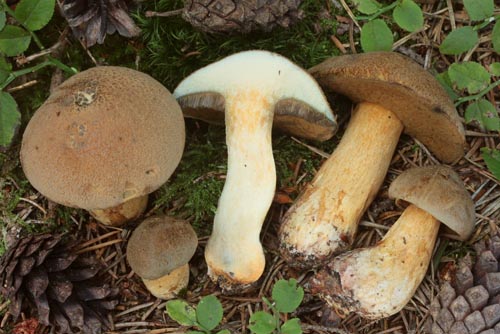
Fruitbodies of Suillus variegatus. (photo M. Mikšík)
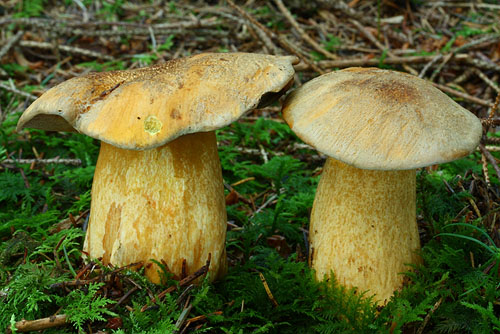
Fruitbodies of Suillus variegatus. Note the dry cap that is quite unusual through the European Suillus. (photo M. Mikšík)

Fruitbodies of Suillus variegatus. (photo B. Assyov)
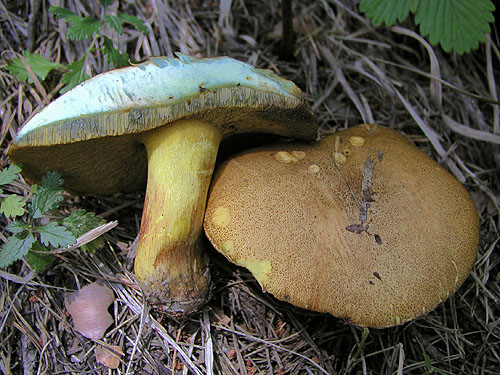
Fruitbodies of Suillus variegatus. Note the blueing of the flesh in the cap, that is very typical for this species. (photo B. Assyov)
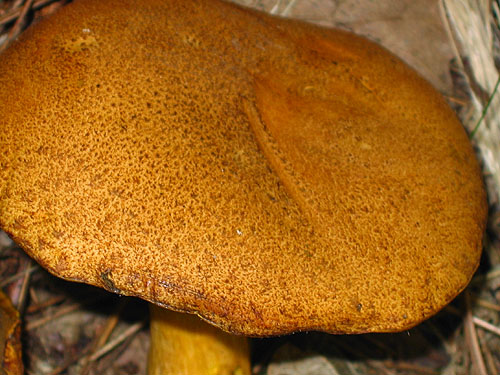
Suillus variegatus - detail of the cap surface. (photo B. Assyov)
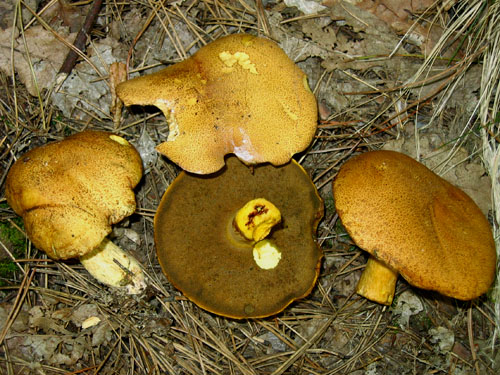
Fruitbodies of Suillus variegatus. Note the colour of the pores and the bright yellow unchanging flesh in the stipe. (photo B. Assyov)
Important literature
Alessio, C.L. 1985. Boletus Dill. ex L. (sensu lato). – In: Fungi Europaei. Vol. 2. Pp. 1–705. Libreria editrice Biella Giovanna, Saronno.
Breitenbach J. & Kränzlin F. 1991. Pilze der Schweiz. Bd. 3(1). Röhrlinge und Blätterpilze. Verlag Mykologia, Luzern.
Engel, H., Dermek, A., Klofac, W., Ludwig, E. & Brückner, T. 1996. Schmier – und Filzröhrlinge s. l. in Europa. Die Gattungen Boletellus, Boletinus, Phylloporus, Suillus, Xerocomus. Verlag Heinz Engel, Weidhausen b. Coburg.
Estadès, A. & Lannoy, G. 2004. Les bolets européens. – Bulletin Mycologique et Botanique Dauphiné-Savoie 44(3): 3–79.
Galli, R. 1998. I Boleti. Atlante pratico-monographico per la determinazione dei boleti. Edinatura, Milano.
Hansen, L. & Knudsen, H. 1992. Nordic Macromycetes. Vol. 2. Polyporales, Boletales, Agaricales, Russulales. Nordsvamp, Copenhagen.
Knudsen, H. & Vesterholt, J. [eds.]. 2008. Funga Nordica. Nordsvamp, Kopenhagen.
Lannoy, G. & Estadès, A. 2001. Les Bolets. Flore mycologique d’Europe. Documents Mycologiques Mémoire Hors série no. 6. Pp. 1–163. Association d’Écologie et de Mycologie, Lille.
Muñoz, J.A. 2005. Boletus s. l. – In: Fungi Europaei. Vol. 1. Pp. 1–951. Edizioni Candusso, Alassio.
Pilát, A. & Dermek, A. 1974. Hríbovité huby. Československé hríbovité a sliziakovité huby (Boletaceae – Gomphidiaceae). Veda, Bratislava.
Šutara, J., Mikšík, M. & Janda, V. 2009. Hřibovité houby. Čeled’ Boletaceae a rody Gyrodon, Gyroporus, Boletinus a Suillus. Academia, Praha.
Watling, R. 1970. Boletaceae, Gomphidiaceae, Paxillaceae. – In: Henderson, D.M., Orton, P.D. & Watling, R. [eds]. British fungus flora. Agarics and Boleti. Vol. 1. Royal Botanic Garden, Edinburgh.